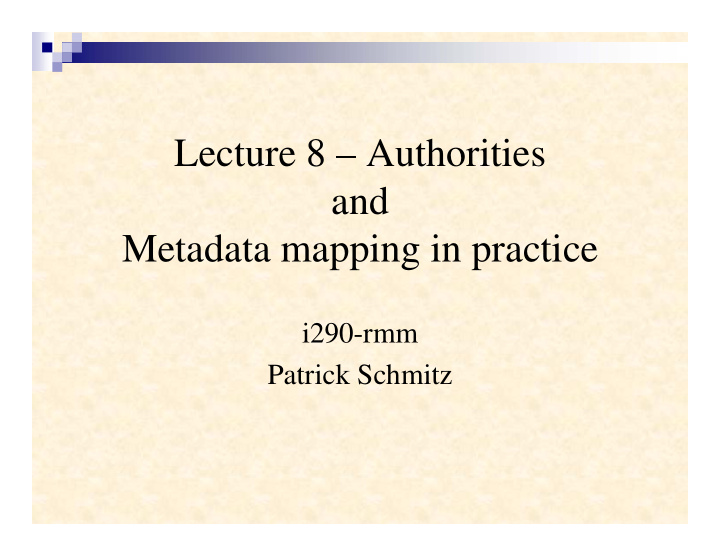



Lecture 8 – Authorities and Metadata mapping in practice i290-rmm Patrick Schmitz
Authorities • Enable term control (consistent usage/reference) – In object, procedural, and media support records – In other authority records (persons in org, etc.) • Comply with ISO and NISO standards for thesauri • Establish preferred terms (among alternates) • Support hierarchy (broader/narrower) • Allow for management of synonyms and related terms, including non-hierarchical "associative relationships" among authorities Lecture 8 Slide 2
Authority types • Person (people, families, etc.) • Organization (museums, companies, etc.) • Place (geographic and political) • Concept (namespaces for material, technique, culture, etc.) • Taxonomy • Storage Location • Stratigraphy, • Etc. Lecture 8 Slide 3
Authority functionality • CRUD on individual records • Search, especially partial-term completion • CRUD on relations, including: – Hierarchy (broader, narrower) – Related terms – Role relations, etc. • Visualization of structure (trees, graphs) Lecture 8 Slide 4
Authority demos • (from resource links in syllabus) Lecture 8 Slide 5
Metadata mapping themes • Business process analysis and UCD • UI concepts and workflow, versus data models • The data model, and the data model • Mapping needs and desires to the possible Lecture 8 Slide 6
Slide 7 Lecture 8
Active Listening Complexity Speaker Complexity Speaker Active Active Listener Listener Presentation Environment Presentation Environment • Intentionally focus on who you are listening to • Goal is to understand what he or she is saying • Repeat back in your own words what they said – To their satisfaction – Not about agreement , but rather understanding Lecture 8 Slide 8
Active Listening – Topic Complexity Complexity Speaker Complexity Speaker Active Active Listener Listener Presentation Environment Presentation Environment • Do you understand the subject matter? • Do you have experience with it? • Is it inherently hard to understand, or simple? • Is it important to you, or just fun? Lecture 8 Slide 9
Active Listening – Speaker Issues Complexity Speaker Complexity Speaker Active Active Listener Listener Presentation Environment Presentation Environment • Is the speaker comfortable, or nervous? • Is speaker expert in the topic? • Is speaker motivated to teach you? • Note speaker’s non-verbal cues Lecture 8 Slide 10
Active Listening – Environment Issues Complexity Speaker Complexity Speaker Active Active Listener Listener Presentation Environment Presentation Environment • Is the space conducive to listening? • Or, to interaction, exchange with speaker? • Are there avoidable distractions? • Are there means for non-verbal communication (e.g., white-board, sketch pads) Lecture 8 Slide 11
Active Listening – Presentation Issues Complexity Speaker Complexity Speaker Active Active Listener Listener Presentation Environment Presentation Environment • Is message illustrated with visuals, or examples? • Is technology available, and effectively used? • How well is message structured? – Are concepts introduced incrementally, in order? – Are processes clearly motivated, e.g. with examples? Lecture 8 Slide 12
Active Listening – You as Listener • Prepare with a positive, engaged attitude • Focus your attention on the subject • Review what you already know about the subject – Prepare relevant material in order to develop it further – Have questions that address your gaps in knowledge • Sit close and avoid distractions • Set aside your prejudices and opinions – You are there to learn from the speaker, not the other way around • Acknowledge any emotional state – Suspend emotions while listening, or just be passive Lecture 8 Slide 13
Active Listening as activity • Be Focused: on the person communicating – Follow and understand the speaker as if you were doing their job – Listen, but also watch, and use your other senses • Be aware: note and acknowledge speaker’s points – Let them finish each point or story – Don't agree or disagree, but encourage train of thought • Be engaged: respond and confirm what they say – Restate key points to affirm your understanding – Ask questions to build your understanding – Thank them for taking time, sharing Lecture 8 Slide 14
Degrees of Active Listening Source: http://en.wikipedia.org/wiki/Active_listening Lecture 8 Slide 15
Steps of Process Mapping Process identification -- attaining a full 1. understanding of all the steps of a process. 2. Information gathering -- identifying objectives, risks, and key controls in a process. Interviewing and mapping -- understanding the 3. point of view of individuals in the process and designing actual maps 4. Analysis -- utilizing tools and approaches to make the process run more effectively and efficiently. Source: Business Process Mapping, John Wiley & Sons Lecture 8 Slide 16
UC Bot Garden Fit-Gap • See resource links on syllabus Lecture 8 Slide 17
Recommend
More recommend